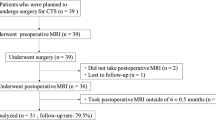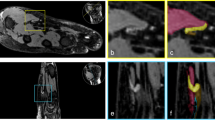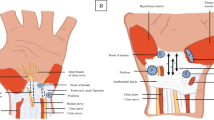Abstract
Objective
To assess the discriminative power of radiomics of peripheral nerves at 1.5T MRI, using common entrapment neuropathies of the upper limb as a model system of focal nerve injury.
Materials and methods
Radiomics was retrospectively done on peripheral nerve fascicles on T1-weighted 1.5T MRI of 40 patients with diagnosis of mild carpal (n = 25) and cubital tunnel (n = 15) syndrome and of 200 controls. Z-score normalization and Mann–Whitney U test were used to compare features of normal and pathological peripheral nerves. Receiver operating characteristic analysis was performed.
Results
A total of n = 104 radiomics features were computed for each patient and control. Significant differences between normal and pathological median and ulnar nerves were found in n = 23/104 features (p < 0.001). According to features classification, n = 5/23 features were shape-based, n = 7/23 were first-order features, n = 11/23 features were classified as gray level run length matrix. Nine of the selected features showed an AUC higher that 0.7: minimum AUC of 0.74 (95% CI 0.61–0.89) for sum variance and maximum AUC of 0.90 (95% CI 0.82–0.99) for zone entropy.
Conclusion
Features analysis demonstrated statistically significant differences between normal and pathological nerve. The results suggested that radiomics analysis could assess the median and ulnar nerve inner structure changes due to the loss of the fascicular pattern, intraneural edema, fibrosis or fascicular alterations in mild carpal tunnel and mild cubital tunnel syndromes even when the nerve cross-sectional area does not change.



Similar content being viewed by others
Abbreviations
- EN:
-
Entrapment neuropathies
- CTS:
-
Carpal tunnel syndrome
- CuTS:
-
Cubital tunnel syndrome
- AUC:
-
Area under the curve
- CI:
-
Confidence interval
- ROC:
-
Receiver operating characteristic
- glrlm:
-
Gray Level Run Length Matrix
References
Gasparotti R, Padua L, Briani C et al (2017) New technologies for the assessment of neuropathies. Nat Rev Neurol 13:203–216
Visalli C, Cavallaro M, Concerto A et al (2018) Ultrasonography of traumatic injuries to limb peripheral nerves: technical aspects and spectrum of features. Jpn J Radiol 36:592–602
Suk JI, Walker FO, Cartwright MS (2013) Ultrasonography of peripheral nerves. Curr Neurol Neurosci Rep 13:328
Wang D, Wang C, Duan X et al (2018) MR T2 value of the tibial nerve can be used as a potential non-invasive and quantitative biomarker for the diagnosis of diabetic peripheral neuropathy. Eur Radiol 28:1234–1241
Kronlage M, Pitarokoili K, Schwarz D et al (2017) Diffusion tensor imaging in chronic inflammatory demyelinating polyneuropathy: diagnostic accuracy and correlation with electrophysiology. Invest Radiol 52:701–707
Tagliafico A, Bignotti B, Tagliafico G, et al Peripheral nerve MRI: precision and reproducibility of T2*-derived measurements at 30-T: a feasibility study. Skeletal Radiol 44:679-686
Tagliafico AS, Tagliafico G (2014) Fascicular ratio: a new parameter to evaluate peripheral nerve pathology on magnetic resonance imaging: a feasibility study on a 3T MRI system. Med (Baltimore) 93:e68
Chhabra A, Madhuranthakam AJ, Andreisek G (2018) Magnetic resonance neurography: current perspectives and literature review. Eur Radiol 28:698–707
Tagliafico AS (2016) Peripheral nerve imaging: not only cross-sectional area. World J Radiol 8:726–728
Tagliafico A, Tagliafico G, Martinoli C (2010) Nerve density: a new parameter to evaluate peripheral nerve pathology on ultrasound. Preliminary study. Ultrasound Med Biol 36:1588–1593
Tagliafico AS (2011) Ulnar neuropathy at the elbow: is MR imaging reliable? Radiology 261:659–660
Bäumer P, Dombert T, Staub F et al (2011) Ulnar neuropathy at the elbow: MR neurography- nerve T2 signal increase and caliber. Radiology 260:199–206
Husarik DB, Saupe N, Pfirrmann CW et al (2009) Elbow nerves: MR findings in 60 asymptomatic subjects- normal anatomy, variants and pitfalls. Radiology 252:148–156
Lambin P, Rios-Velazquez E, Leijenaar R et al (2012) Radiomics: extracting more information from medical images using advance feature analysis. Eur J Cancer 48:441–446
Gillies RJ, Kinahan PE, Hricak H (2016) Radiomics: images are more than pictures, they are data. Radiology 278:563–577
Lambin P, Leijenaar RTH, Deist TM et al (2017) Radiomics: the bridge between medical imaging and personalized medicine. Nat Rev Clin Oncol 14:749–762
Koh SH, Kwon BC, Park C et al (2014) A comparison of the performance of anatomical MRI and DTI in diagnosing carpal tunnel syndrome. Eur J Radiol 83:2065–2073
Fedorov A, Beichel R, Kalpathy-Cramer J et al (2012) 3D Slicer as an image computing platform for the quantitative imaging network. Magn Reson Imaging 30:1323–1341
Parmar C, Rios Velazques E, Leijenaar R et al (2014) Robust radiomics feature quantification using semiautomatic volumetric segmentation. PLoS ONE 9:e102107
Padua L, Lo Monaco M, Padua R (1997) Neurophysiological classification of carpal tunnel syndrome: assessment of 600 symptomatic hands. Ital J Neurol Sci 18:145–150
Gu Y (2011) Current status and suggestion of clinical classification of carpal and cubital tunnel syndromes. Zhongguo Gu Yu Guan Jie Sun Shang Za Zhi. 31:818–819
Parekh V, Jacobs MA (2016) Radiomics: a new application from established techniques. Expert Rev Precis Med Drug Dev 1:207–226
Bianchi S, Martinoli C (2007) Ultrasound of the musculoskeletal system. Springer, Bonn
Subhawong TK, Wang KC, Thawait SK, Williams EH et al (2012) High resolution imaging of tunnels by magnetic resonance neurography. Skeletal Radiol 41:15–31
Galloway MM (1975) Texture analysis using gray level run lengths. Comput Gr Image Process 4:172–179
Tustison N, Gee J (2008) Run-Length Matrices For Texture Analysis. Insight J 1-6
Zwanenburg, A., Leger, S., Vallières, et al (2016) Image biomarker standardisation initiative - feature definitions. arXiv preprint arXiv 1612
Balsiger F, Steindel C, Arn M et al (2018) Segmentation of peripheral nerves from magnetic resonance neurography: a fully-automatic. Deep learning-based approach. Front Neurol 19(9):777
Felisaz PF, Balducci F, Gitto S et al (2016) Nerve fascicles and epineurium volume segmentation of peripheral nerve using magnetic resonance micro-neurography. Acad Radiol 23:1000–1007
Felisaz PF, Maugeri G, Busi V, et al (2017) MR Micro-neurography and a segmentation protocol applied to diabetic neuropathy. Radiol Res Pract 2761818
Acknowledgements
One author has received research grants from the European Society of Musculoskeletal Radiology (ESSR), Young Researchers Grant 2018.
Funding
This study was funded by the European Society of Musculoskeletal Radiology (ESSR),Young Researchers Grant 2018.
Author information
Authors and Affiliations
Contributions
Scientific Guarantor: AT. Data collection and analysis: AT, BB, FV, FR. Manuscript drafting and final approval: all Authors.
Corresponding author
Ethics declarations
Conflict of interest
Rossi Federica has received research grants from the European Society of Musculoskeletal Radiology (ESSR), Young Researchers Grant 2018.
Ethical approval
All procedures performed in studies involving human participants were in accordance with the ethical standards of the institutional and/or national research committee and with the 1964 Helsinki Declaration and its later amendments or comparable ethical standards.”
Informed consent
Informed consent was obtained from all individual participants included in the study.
Additional information
Publisher's Note
Springer Nature remains neutral with regard to jurisdictional claims in published maps and institutional affiliations.
Rights and permissions
About this article
Cite this article
Rossi, F., Bignotti, B., Bianchi, L. et al. Radiomics of peripheral nerves MRI in mild carpal and cubital tunnel syndrome. Radiol med 125, 197–203 (2020). https://doi.org/10.1007/s11547-019-01110-z
Received:
Accepted:
Published:
Issue Date:
DOI: https://doi.org/10.1007/s11547-019-01110-z




